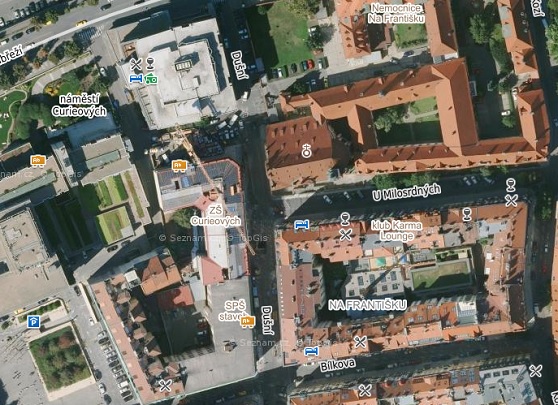
On Curieových Square in Prague, a seven-story building could be built
 |
Prague - In the center of Prague, a seven-story building could rise in Curie Square. In the proposed Metropolitan Plan, the vacant area between the InterContinental Hotel, Eliška Krásnohorské Street, and Bílková Street is marked as a building plot, rather than as an inaccessible public space. This was stated today by the councilor for the environment, Jana Plamínková (STAN/Trojkoalice). The changes are not definitive; city districts and residents will have the opportunity to express their opinions on the Metropolitan Plan proposal. The newspaper Právo informed about the construction plans in recent days. The representatives of the Pirate Party demand that the city publish a list of all similar plots.
"I am quite concerned that there may be more such minor, inconspicuous changes in the new zoning plan. I believe this is not good because the center of Prague is already very densely populated," said Plamínková, adding that such places should be protected and utilized for expanding greenery, which can help reduce air temperature in the city. According to Plamínková, it would be possible to increase housing density in Prague in so-called brownfields or on housing estates.
The city district views the change of Curie Square to a construction plot negatively, especially if the owner, the company J&T, were to build an office building there, as previously reported by Právo. "Prague 1 would be fundamentally against such construction. However, if it were only some minor adjustments to the square that wouldn't destroy this place but rather improve it a bit, then in general, the change to a construction plot wouldn’t be problematic," stated Veronika Blažková, spokesperson for Prague 1, in response to ČTK's inquiry.
The Pirate Party council club demands that the Institute of Planning and Development (IPR), which is preparing the Metropolitan Plan, publish a list of plots that the plan proposes to change from non-buildable to buildable, thus increasing the value for their owners. The head of the Pirate Party club, Jakub Michálek, sent an official request for information to the institute in this regard. "I want to know whether the IPR is preparing a zoning plan that mainly benefits billionaires, or if Curie Square was just an exceptional exception," he stated in a press release.
"Changing non-buildable plots, regardless of whether they are green spaces or public areas into construction plots is an extraordinary matter, especially if it takes place in such a valuable and complex area as the historic core of Prague. These matters need to be broadly discussed, especially clarifying questions about whose benefit this change is being made, whether it is in the interest of the city and its residents, and what the city and its residents will gain and lose by it," conveyed Ondřej Šefců from the National Heritage Institute (NPÚ) generally regarding the zoning plan changes to ČTK.
Organizations such as the Association of Citizens and Friends of the Old Town and Josefov in Prague, We Live in the Center, Club for Old Prague, or KampaNula have already protested against the changes to the zoning plan.
Another location where construction could arise is on the banks of the Vltava River near Štefánik Bridge. The city council narrowly approved a change to the zoning plan on Tuesday that aims to transform the current park at the end of Revoluční Street into a building plot. The city district of Prague 1 wants to utilize the space for cultural purposes. Originally, the Prague 1 City Hall considered building the Golden Egg gallery project by architect Petr Malinský, but the city district no longer insists on this plan. Prague 1 planned to place the Slav Epic in the gallery, but the magistrate decided to build a gallery for the epic on Těšnov.
In the fight against climate change, the magistrate adopted a city adaptation strategy in July, stating that green and blue infrastructure should be supported to cool the city and prevent manifestations of the urban heat island effect. Due to this phenomenon, the temperature in the center of Prague is two to three degrees higher than in its periphery, caused by the densification of construction using materials that accumulate heat, such as concrete and asphalt. The temperature is further increased by traffic intensity and a small amount of greenery, which has the ability to hold water and cool the air through evaporation.
The English translation is powered by AI tool. Switch to Czech to view the original text source.
0 comments
add comment







